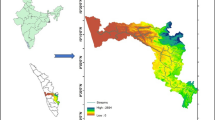Abstract
The method of fractal geometry allows the simulation as well as description of data of many different natural states of orientation, distribution and consistency. This affords to the engineering geologist various new possibilities of identifying rock mass and rock. We have tried to use fractal dimension (FD) for characterising roughness profiles of shear faces as well as fracture trace maps of foundation surfaces. Fractal dimension proved to be a characteristic which—difficult to determine by other methods—is a valuable aid in describing and identifying rock masses in terms of geology and geotechnics. The collection of data as well as the representation and adequate, interpretation of the results, however, call for a further improvement of methods and additional experience.
Résumé
Le concept de «géométrie fractale» permet de simuler et de décrire les données de divers états d'orientation, de distribution et de consistance. Ceci offre à l'ingénieur géologique quelques nouveaux moyens de caractériser les massifs rocheux et les roches. Et nous servant de la «dimension fractale» (FD), nous avons essayé de caractériser des profils de rugosité pour des faces de cisaillement ainsi que des cartes de traces de fractures pour des surfaces de fondation. On a constaté que la «dimension fractale», difficile à déterminer par d'autres méthodes, représente une caractéristique qui aide à décrire et identifier les massifs rocheux des points de vue géologique et géotechnique. La collection des données ainsi que la représentation et interprétation adéquate des résultats ont pourtant besoin de méthodes encore améliorées et d'expérience supplémentaire.
Similar content being viewed by others
References
BARTON N.R., 1973: Review of a new shear strength criterion for rock joint.—Engin. Geol. 7; 287–332.
BARTON C.C., LARSEN E., 1986: Fractal geometry of two dimensional fracture networks at Yucca Mountain, southern Nevada.— Proc. Int. Symp. Fundamentals of Rock Joints/Björkliden 1985; 77–84.
BROSCH F.J., RIEDMÜLLER G, 1987: Zur Baugeologie der Gründung des Murkraftwerkes Rabenstein.—Felsbau 5/4; 188–194.
BROSCH F.J., RIEDMÜLLER G., NOHER H.P., 1990: Großscherversuche beim Bau des Murkraftwerkes Rabenstein.—Felsbau 8/1; 38–46.
CARR J.R, 1989: Stochastic versus determininstic fractals: the controversy over applications in the earth sciences.—Engineering Geology and Geotechnical Engineering (R.J. Watters, ed.); 297–308; Balkema Rotterdam).
CHELIDZE T., GUEGUEN Y., 1990: Evidence of fractal fracture. —Int. J. Rock. Mech. Min. Sci. & Geomech. Abstr. 22/3; 223–225.
CULLING W.E.H., 1989: The characterisation of regular/irregular surfaces in the soil-covered landscape by Gaussian random fields. —Computers & Geosciences 15/2; 219–226.
HAYWARD J., ORFORD J.D., WHALLEY W.B., 1989: Three implementations of fractal analysis of particle outlines.—Computers & Geosciences 15/2; 199–208.
HIRATA T., SATOH T., ITO K., 1987: Fractal structure of spatial distribution of microfracturing in rock.—Geophys. J. Roy. Astr. Soc. 90; 369–374.
HIRATA T., 1989: Fractal dimensions of fault systems in Japan: fractal structure in rock fracture at various scales—PAGEOPH. 131/1/2; 157–170.
KORVIN G., 1989: Fractured but not fractal: fragmentation of the Gulf of Suez basement.—PAGEOPH, 131/1/2; 289–305.
LEE Y.H., CARR J.R., BARR D.J., HAAS C.J., 1990: The fractal dimension as a measure of the roughness of rock discontinuity profiles.—Int. J. Rock Mech. Min. Sci. & Geomech. Abstr. 27/6: 453–464.
MANDELBROT B.B., 1967: How long is the coast of Britain?— Statistical self similarity and fractal dimension.—Science 156: 636–638.
MANDELBROT B.B., 1977: Fractals: form, chance and dimension. —Freeman (San Francisco), 365 p.
MANDELBROT B.B., 1983: The fractal geometry of nature.—Freeman (New York), 460 p.
NOHER H.P., RIEDMÜLLER G. 1988: Geotechnische Aspekte im Bereich der Baugrube-Feldversuche zur Charakterisierung der Festgesteine.—ÖZE 41/12; 438–444.
POULTON M.M., MOJTABAI N., FARMER I.W., 1990: Scale invariant behaviour of massive and fragmented rock.—Int. J. Rock Mech. Min. Sci. & Geomech. Abstr. 27/3; 219–221.
RICHARDSON L.F., 1961: The problem of contiguity: an appendix of statistics of deadly quarrels.—General Systems Yearbook 6: 139–188.
SAMMIS C.G., BIEGEL R.L., 1989: Fracalss, fault gouge, and friction. —PAGEOPH, 131/1/2; 255–272.
SCHOLZ C.H., 1990: The mechanics, of earthquakes and faulting —Cambridge University Press (Cambridge etc.); 439 p.
TURK N., GREIG M.J., DEARMAN W.R., AMIN F.F., 1987: Characrerization of rock joint surfaces by fractal dimension.—Proc 28th U.S. Rock Mech. Symp.; 1223–1236.
Author information
Authors and Affiliations
Rights and permissions
About this article
Cite this article
Brosch, F.J., Pölsler, P. & Riedmüller, G. The use of fractal dimension in engineering geology. Bulletin of the International Association of Engineering Geology 45, 83–88 (1992). https://doi.org/10.1007/BF02594907
Published:
Issue Date:
DOI: https://doi.org/10.1007/BF02594907




